American Frontier from Wikipedia
| The American frontier comprises
the geography, history, folklore, and cultural expression of life in the
forward wave of American westward expansion from the original colonial
settlements to the early 20th century. Enormous popular attention in the
media focuses on the second half of the 19th century, a period sometimes
called the Old West, or the Wild West. As defined by Hine and Faragher,
"frontier history tells the story of the creation and defense of communities,
the use of the land, the development of markets, and the formation of states."
They explain, "It is a tale of conquest, but also one of survival, persistence,
and the merging of peoples and cultures that gave birth and continuing
life to America." Through treaties with foreign nations and native tribes,
political compromise, military conquest, establishment of law and order,
building farms, ranches and towns, marking trails and digging mines, and
pulling in great migrations of foreigners, the United States expanded from
coast to coast fulfilling the dreams of Manifest destiny. As the American
frontier passed into history, the myths of the west in fiction and film
took firm hold in the imagination of Americans and foreigners alike. America
is exceptional in choosing its iconic self-image. "No other nation," says
David Murdoch, "has taken a time and place from its past and produced a
construct of the imagination equal to America's creation of the West."
The term "West"
The frontier line--the outer line of settlement—moved
steadily westward from the 1630s to the 1880s (with occasional movements
north into Maine and Vermont, south into Florida, and east from California
into Nevada). The "West" was always the area beyond that boundary. Most
often, however, the term "American West" is used for the area west of the
Mississippi River during the 19th century. Thus, the Midwest and parts
of the American South, though no longer considered "western," have a frontier
heritage along with the modern western states.
|
.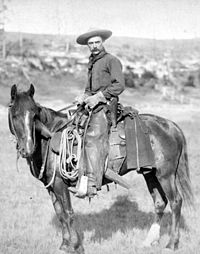
The cowboy, the quintessential
symbol of the American frontier,
circa 1888 |
| Colonial frontier - Thirteen Colonies
In the colonial era, before 1776, the west was of high
priority for settlers and politicians. In the earliest days of European
settlement of the Atlantic coast, from about 1600 to 1680, the frontier
was essentially any part of the forested interior of the continent beyond
the fringe of existing settlements along the coast. English, French, Spanish
and Dutch patterns of expansion and settlement were quite different. Only
a few thousand French migrated to Canada; these habitants settled in villages
along the St. Lawrence river, building communities that remained stable
for long stretches; they did not simply jump west the way the British did.
Although French fur traders ranged widely through the Great Lakes region
they seldom settled down. Likewise, the Dutch set up fur trading posts
in the Hudson River valley, followed by large grants of land to rich landowning
patroons who brought in tenant farmers who created compact, permanent villages.
They did not push westward. By contrast the British settlements gave priority
to land ownership to individual farmers.
In contrast, the English colonies generally pursued a
more systematic policy of widespread settlement of the New World for cultivation
of the land. Unlike Britain, where a small number of landlords owned most
of the good land, ownership in America was cheap, easy and widespread.
Land ownership brought a degree of independence as well as a vote for local
and provincial offices. The typical New England settlements were quite
compact and small—under a square mile. Conflict with the Native Americans
arose out of political issues, viz. who would rule. Early frontier areas
east of the Appalachian Mountains included the Connecticut River valley,
and northern New England (which was a move to the north, not the west).
The French and Indian Wars of the 1760s turned out a complete
victory for the British, who took over the western lands to the Mississippi
River. By the early 1770s Americans were moving across the Appalachians
into western Pennsylvania, and areas of Ohio, Kentucky and Tennessee. Their
most famous leader was Daniel Boone.
Advancing frontier and the Louisiana
Purchase
After winning the Revolutionary
war (1783), American settlers in large numbers poured into the west. In
1788, American pioneers to the Northwest Territory established Marietta,
Ohio as the first permanent American settlement in the Northwest Territory.
In 1775, Daniel Boone blazed a trail
for the Transylvania Company from Virginia through the Cumberland Gap into
central Kentucky. It was later lengthened to reach the Falls of the Ohio
at Louisville. The Wilderness Road was steep and rough, and it could only
be traversed on foot or horseback, but it was the best route for thousands
of settlers moving into Kentucky. In some areas they had to face Indian
attacks. In 1784 alone, Indians killed over 100 travelers on the Wilderness
Road. No Indians lived permanently in Kentucky but they sent raiding parties
to stop the newcomers, like Abe Lincoln's grandfather (who was scalped
in 1784 near Louisville.)
|
.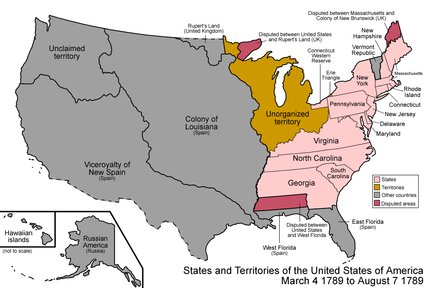
.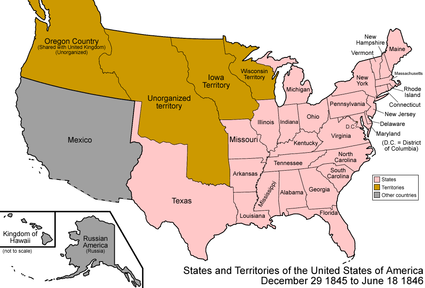
.
|
| Acquisition of Indian lands
The War of 1812 marked the final
confrontation between major Indian forces trying to stop the advance, with
British aid. The British war goal included the creation of an independent
Indian state (under British auspices) in the Midwest. American frontier
militiamen under General Andrew Jackson defeated the Creeks and opened
the Southwest, while militia under Governor William Henry Harrison defeated
the Indian-British alliance at the Battle of the Thames in Canada in 1813.
The death in battle of the Indian leader Tecumseh dissolved the coalition
of hostile Indian tribes. Meanwhile General Andrew Jackson ended the Indian
military threat in the Southeast at the Battle of Horseshoe Bend in 1814
in Alabama. In general the frontiersmen battled the Indians with little
help from the U.S. Army or the federal government.
To end the War of 1812 John Quincy
Adams, Henry Clay and Albert Gallatin (a leading anthropologist) and the
other |
.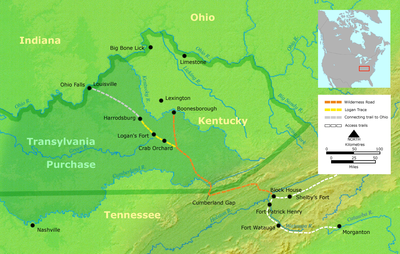
Map of the Wilderness Road by 1785. |
American diplomats negotiated the Treaty
of Ghent in 1814 with Britain. They rejected the British plan to set up
an Indian state in U.S. territory south of the Great Lakes. They explained
the American policy toward acquisition of Indian lands:
| The United States, while intending
never to acquire lands from the Indians otherwise than peaceably, and with
their free consent, are fully determined, in that manner, progressively,
and in proportion as their growing population may require, to reclaim from
the state of nature, and to bring into cultivation every portion of the
territory contained within their acknowledged boundaries. In thus providing
for the support of millions of civilized beings, they will not violate
any dictate of justice or of humanity; for they will not only give to the
few thousand savages scattered over that territory an ample equivalent
for any right they may surrender, but will always leave them the possession
of lands more than they can cultivate, and more than adequate to their
subsistence, comfort, and enjoyment, by cultivation. If this be a spirit
of aggrandizement, the undersigned are prepared to admit, in that sense,
its existence; but they must deny that it affords the slightest proof of
an intention not to respect the boundaries between them and European nations,
or of a desire to encroach upon the territories of Great Britain. . . .
They will not suppose that that Government will avow, as the basis of their
policy towards the United States a system of arresting their natural growth
within their own territories, for the sake of preserving a perpetual desert
for savages. |
New territories and states
As settlers poured in, the frontier
districts first became territories, with an elected legislature and a governor
appointed by the president. Then when population reached 100,000 the territory
applied for statehood. Frontiersmen typically dropped the legalistic formalities
and restrictive franchise favored by eastern upper classes, and adopting
more democracy and more egalitarianism. |
.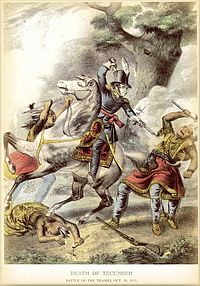
Indian leader Tecumseh killed in
battle in 1813 by Richard M. Johnson,
who later becomes Vice president |
.
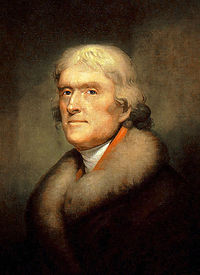 . . |
Thomas Jefferson thought of himself
as a man of the frontier and was keenly interested in expanding and exploring
the West. Jefferson's Louisiana Purchase of 1803 doubled the size of the
nation at the cost of $15 million (about $0.04 per acre). Federalists opposed
the expansion, but Jeffersonians hailed the opportunity to create millions
of new farms to expand the domain of land-owning yeomen; the ownership
would strengthen the ideal republican society, based on agriculture (not
commerce), governed lightly, and promoting self-reliance and virtue, as
well as form the political base for Jeffersonian Democracy.
Even before the purchase Jefferson
was planning expeditions to explore and map the lands. He charged Lewis
and Clark to "explore the Missouri River, and such principal stream of
it, as, by its course and communication with the waters of the Pacific
Ocean; whether the Columbia, Oregon, Colorado or any other river may offer
the most direct and practicable communication across the continent for
the purposes of commerce". Jefferson also instructed the expedition to
study the region's native tribes (including their morals, language, and
culture), weather, soil, rivers, commercial trading, animal and plant life.
Entrepreneurs, most notably John
Jacob Astor quickly seized the opportunity and expanded fur trading operations
into the Pacific Northwest. Aster's "Fort Astoria" (later Fort George), |
at the mouth of the Columbia River,
became the first permanent white settlement in that area, although it was
not profitable for Astor. Astor by 1820, took over independent traders
to create a profitable monopoly; he left the business as a multi-millionaire
in 1834.
| The fur trade
As the frontier moved westward, trappers and hunters moved
ahead of settlers, searching out new supplies of beaver and other skins
for shipment to Europe. The hunters were the first Europeans in much of
the Old West and they formed the first working relationships with the Native
Americans in the West. They added extensive knowledge of the Northwest
terrain, including the important South Pass through the central Rocky Mountains.
Discovered about 1812, it later became a major route for settlers to Oregon
and Washington. By 1820 a new "brigade rendezvous" system, however, sent
company men in "brigades" cross-country on long expeditions, bypassing
many tribes. It also encouraged "free trappers" to explore new regions
on their own. At the end of the gathering season, the trappers would "rendezvous"
and turn in their goods for pay at river ports along the Green River, the
Upper Missouri, and the Upper Mississippi. St. Louis was the largest of
the rendezvous towns. By 1830, however, fashions changed and beaver hats
were replaced by silk hats, ending the demand for expensive American furs.
Thus ended the era of the mountain men, trappers and scouts such as Jedediah
Smith (who had traveled through more unexplored western land than any non
Indian and was the first American to reach California overland). The trade
in beaver fur virtually ceased by 1845.
The federal government and the West
The private profit motive dominated the movement westward,
but the Federal Government played a supporting role in securing land through
treaties and setting up territorial governments, with governors appointed
by the President. The federal government first acquired western territory
from other nations or native tribes by treaty, then it sent surveyors to
map and document the land. By the 20th centuries Washington bureaucracies
managed the federal lands such as the General Land Office in the Interior
department, and after 1891 the Forest Service in the Department of Agriculture.
After 1900 dam building and flood control became major concerns.
Transportation was a key issue and the Army (especially
the Army Corps of Engineers) was given full responsibility for facilitating
navigation on the rivers. The steamboat, first used on the Ohio River in
1811, made possible inexpensive travel using the river systems, especially
the Mississippi and Missouri rivers and their tributaries. Army expeditions
up the Missouri River in 1818-25 allowed engineers to improve the technology.
For example, the Army's steamboat "Western Engineer" of 1819 combined a
very shallow draft with one of the earliest stern wheels. In 1819-25 Colonel
Henry Atkinson developed keelboats with hand powered paddle wheels. |
.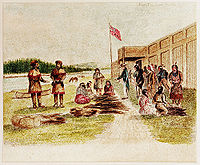
Fur trading at Fort Nez Percés in 1841
.
Plate from Audubon's
Birds of America |
Scientists, artists and explorers
Government and private enterprise sent many explorers
to the West. In 1805-6, Army lieutenant Zebulon Pike (1779–1813) led a
party of 20 soldiers to find the head waters of the Mississippi. He later
explored the Red and Arkansas Rivers in Spanish territory, eventually reaching
the Rio Grande. On his return, Pike sighted the peak in Colorado named
after him, was captured by the Spanish and released after a long overland
journey. Unfortunately, his documents were confiscated to protect territorial
secrets and his later recollections were rambling and not of high quality.
Major Stephen Harriman Long (1784–1864) led the Yellowstone and Missouri
expeditions of 1819-1820, but his categorizing in 1823 of the Great Plains
as arid and useless led to the region getting a bad reputation as the "Great
American Desert", which discouraged settlement in that area for several
decades.
In 1811, naturalists Thomas Nuttall (1786–1859) and John
Bradbury (1768–1823) traveled up the Missouri River with the Astoria expedition,
documenting and drawing plant and animal life. Later, Nuthall explored
the Indian Territory (Oklahoma), the Oregon Trail, and even Hawaii. His
book A Journal of Travels into the Arkansas Territory was an important
account of frontier life. Although Nuthall was the most traveled Western
naturalist before 1840, unfortunately most of his documentation and specimens
were lost. Artist George Catlin (1796–1872) traveled up the Missouri as
far as North Dakota, producing accurate paintings of Native American culture.
A Swiss visitor Karl Bodmer (1809–93), was in the U.S. in 1832-34 with
the Prince Maximilian expedition; he made compelling landscapes and portraits.
In 1803 John James Audubon (1785–1851) immigrated from Haiti and established
a reputation as a leading explorer, woodsman, painter, and naturalist.
His greatest achievement involved classifying and painting in minute details
500 species of birds.
The most famous of the explorers was John Charles Frémont
(1813–1890), a commissioned officer in the Army's Corps of Topographical
Engineers. He displayed a talent for exploration and a genius at self promotion
that gave him the sobriquet of "Pathmarker of the West" and led him to
the presidential nomination of the new Republican Party in 1856. He led
a series of expeditions in the 1840s which answered many of the outstanding
geographic questions about the little-known region. He crossed through
the Rocky Mountains by five different routes, and mapped parts of Oregon
and California. In 1846-7 he played a role in conquering California. In
1848-49, Frémont was assigned to locate a central route through
the mountains for the proposed transcontinental railroad, but his expedition
ended in near disaster when it became lost and was trapped by heavy snow.
His reports mixed narrative of exciting adventure with scientific data,
and detailed practical information for travelers. It caught the public
imagination and inspired many to head west. Goetzman says it was "monumental
in its breadth--a classic of exploring literature."
The Antebellum West
| Southwest
From the 1770s to the 1830s pioneers moved into the new
lands that stretched from Kentucky to Alabama to Texas. Most were farmers
who moved in family groups. Historian Frederick Jackson Turner explored
their individualistic world view and values:
"What they objected to was arbitrary obstacles, artificial
limitations upon the freedom of each member of this frontier folk to work
out his own career without fear or favor. What they instinctively opposed
was the crystallization of differences, the monopolization of opportunity
and the fixing of that monopoly by government or by social customs. The
road must be open. The game must be played according to the rules. There
must be no artificial stifling of equality of opportunity, no closed doors
to the able, no stopping the free game before it was played to the end.
More than that, there was an unformulated, perhaps, but very real feeling,
that mere success in the game, by which the abler men were able to achieve
preeminence gave to the |
.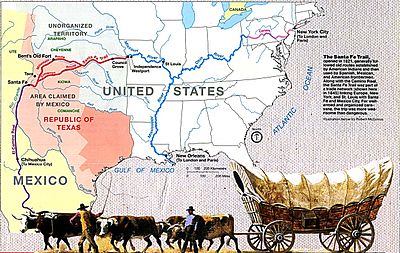
Map of the Santa Fe Trail |
successful ones no right to look down upon their neighbors,
no vested title to assert superiority as a matter of pride and to the diminution
of the equal right and dignity of the less successful."
Manifest Destiny and the early migrations
Manifest Destiny was the belief that the United States
was pre-ordained to expand from the Atlantic coast to the Pacific coast.
The concept was expressed during Colonial times, but the term was coined
in the 1840s and became a rallying cry for expansionists in the Democratic
Party in the 1840s. The Tyler and Polk administrations (1841–48) successfully
promoted this nationalistic doctrine over Whigs who wanted to concentrate
on modernization and urbanization, and anti-slavery elements who tried
to keep slavery out of the new territories so that white families could
own and operate their own farms instead of having planters buy up the best
lands and work them with gangs of slaves. Starting with the annexation
of Texas, the expansionists got the upper hand. John Quincy Adams, an anti-slavery
Whig, felt the Texas annexation in 1845 to be "the heaviest calamity that
ever befell myself and my country".
Helping settlers move westward were the emigrant "guide
books" of the 1840s featuring route information supplied by the fur traders
and the Frémont expeditions, and promising fertile farm land beyond
the Rockies.
Mexico and Texas
| Mexico became independent of Spain in 1821, and took
over Spain's northern possessions stretching from Texas to California.
Caravans began delivering goods to Mexico's Santa Fe along the Santa Fe
Trail, over the 870 mile (1,400 km) journey which took 48 days from Kansas
City, Missouri (then known as Westport). Santa Fe was also the trailhead
for the "El Camino Real" (the King's Highway), a trade route which carried
American manufactured goods southward deep into Mexico and returned silver,
furs, and mules northward (not to be confused with another "Camino Real"
which connected the missions in California). A branch also ran eastward
near the Gulf (also called the Old San Antonio Road). Santa Fe connected
to California via the Old Spanish Trail.
The Spanish and Mexican governments attracted American
settlers to Texas with generous terms. Stephen F. Austin became an "empresario,"
receiving contracts from the Mexican officials to bring in |
.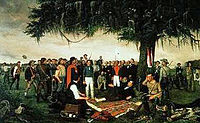
Sam Houston accepting the surrender
of Mexican general Santa Anna, 1836 |
immigrants. In doing so, he also became the de facto political
and military commander of the area. Tensions rose, however, after an abortive
attempt to establish the independent nation of Fredonia in 1826. William
Travis, leading the "war party," advocated for independence from Mexico,
while the "peace party" led by Austin attempted to get more autonomy within
the current relationship. When Mexican president Santa Anna shifted alliances
and joined the conservative Centralist party, he declared himself dictator
and ordered soldiers into Texas to curtail new immigration and unrest.
However, immigration continued and 30,000 Americans with 3,000 slaves arrived
in 1835. A series of battles, including massacres of Texans at the Alamo,
at Goliad, ended in a decisive Texas victory at the Battle of San Jacinto.
Texans established the independent Republic of Texas in 1836. The U.S.
Congress, however, refused to annex Texas, stalemated by contentious arguments
over slavery and regional power. Texas remained an independent country,
led by Sam Houston, until it was established to become the 28th state in
1845. The government of Mexico, however, viewed Texas as a runaway province
and asserted its ownership.
The Mexican–American War
Mexico refused to recognize the independence of Texas
in 1836, although most major nations did so. It threatened war if Texas
joined the U.S., which it did in 1845. President James K. Polk sent negotiators
but they were rejected by Mexico, whose government was in turmoil. The
Mexican army killed an American unit in territory claimed by both nations,
and both sides were eager for war. Whigs, such as Congressman Abraham Lincoln
denounced the war, but it was quite popular outside New England.
The Mexican strategy was defensive; the American strategy
was a three pronged offensive, using large numbers of volunteer soldiers.
Overland forces seized New Mexico with little resistance and headed to
California, which quickly fell to the American land and naval forces. From
the main American base at New Orleans, General Zachary Taylor led forces
into northern Mexico, winning a series of battles that ensued. The Navy
took General Winfield Scott to Veracruz. He then marched his 12,000 man
force west to Mexico City, winning the final battle at Chapultepec. Talk
of acquiring all of Mexico fell away when the army discovered the Mexican
political and cultural values were so alien to America's. As the Cincinnati
Herald asked, what would the U.S. do with eight million Mexicans "with
their idol worship, heathen superstition, and degraded mongrel races?"
The Treaty of Guadalupe Hidalgo of 1848 ceded the territories
of California and New Mexico to the United States for $18.5 million (which
included the assumption of claims against Mexico by settlers). The Gadsden
Purchase in 1853 added southern Arizona, which was needed for an anticipated
railroad route. The completed Mexican cession covered over half a million
square miles and increased the size of the U.S. by nearly 20% and included
the states-to-be of California, Utah, Arizona, Nevada, New Mexico, and
parts of Colorado and Wyoming. Managing the new territories and dealing
with the slavery issue were challenges which lay ahead. Intense controversy
arose with the Wilmot Proviso, which would outlaw slavery in the new territories.
It never passed, and the issue of slavery in the West seemed to be resolved
with the Compromise of 1850. California entered the Union in 1850 as a
free state; the other areas would remain territories for many years.
The California Gold Rush
| In 1846 about 10,000 Californios (Hispanics) lived in
California, primarily on cattle ranches in what is now the Los Angeles
area. A few hundred foreigners were scattered in the northern districts,
including some Americans. With the outbreak of war with Mexico in 1846
the U.S. sent in Frémont and an army unit, as well as naval forces,
and quickly took control. As the war was ending gold was discovered in
the north, and the word soon spread worldwide.
Thousands of "Forty-Niners" reached California, by sailing
around South America (or taking a short-cut through disease ridden Panama),
or walked the California trail. The population soared to over 200,000 in
1852, mostly in the gold districts which stretched into the mountains east
of San Francisco.
San Francisco saw hastily erected housing—often docked
ships whose crews had headed for the mines. Out in the gold fields living
conditions were primitive, though the mild climate proved attractive. Supplies
were expensive and food poor, typical diets consisting mostly of pork,
beans, and whiskey. These highly male, transient communities with no established
institutions were prone to high levels of violence, drunkenness, profanity,
and greed driven behavior. Without courts or law officers in the mining
communities to enforce claims and justice, miners developed their own ad
hoc legal system, based on the "mining codes" used in other mining communities
abroad. Each camp had its own rules and often handed out justice by popular
vote, sometimes acting fairly and at times exercising vigilantism—with
Indians, Mexicans, and Chinese generally receiving the harshest sentences.
The gold rush radically changed the California economy
and brought in an array of professionals, including precious metal specialists,
merchants, doctors, and attorneys, who supplemented the numerous miners,
saloonkeepers, gamblers, and prostitutes. A San Francisco newspaper stated,
"The whole country... resounds to the sordid cry of gold! Gold! Gold! while
the field is left half planted, the house half built, and everything neglected
but the manufacture of shovels and pick axes." Over |
.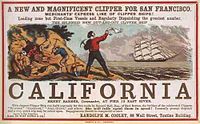
Clipper ships took 5 months to sail
the 17,000 miles from
New York to San Francisco
.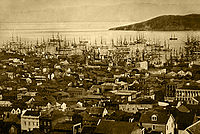
San Francisco harbor c. 1850.
Between 1847 and 1870, the
population of San Francisco
exploded from 500 to 150,000. |
250,000 miners found a total of more than $200 million in
gold in the five years of the California Gold Rush. As thousands arrived,
however, fewer and fewer miners struck their fortune, and most ended exhausted
and broke.
Camps spread out north and south of the American River
and eastward into the Sierras. In a few years, nearly all of the independent
miners were displaced as mines were purchased and run by mining companies,
who then hired low paid salaried miners. As gold became harder to find
and more difficult to extract, individual prospectors gave way to paid
work gangs, specialized skills, and mining machinery. Bigger mines, however,
caused greater environmental damage. In the mountains, shaft mining predominated,
producing large amounts of waste.
The mountainous areas of the triangle from New Mexico
to California to South Dakota contained hundreds of hard rock mining sites,
where prospectors discovered gold, silver, copper and other minerals (as
well as some soft rock coal). Temporary mining camps sprang up overnight;
most became ghost towns when the ores were depleted.
The discovery of the Comstock Lode, containing vast amounts
of silver, resulted in the Nevada boomtowns of Virginia City, Carson City,
and Silver City. The wealth from silver, more than from gold, fueled the
maturation of San Francisco in the 1860s and helped the rise of some of
its wealthiest families, such as that of George Hearst.
Prospectors spread out and hunted for gold and silver
along the Rockies and in the southwest. Soon gold was discovered in Colorado,
Utah, Arizona, New Mexico, Idaho, Montana, and South Dakota (by 1864).
The Oregon Trail
| To get to the rich new lands of the West Coast, some
people sailed for six months, but 400,000 others walked 2,000 miles in
six months in wagon trains that left from Missouri. They moved in large
groups under an experienced wagon master, bringing their clothing, farm
supplies, and animals. They followed the main rivers, crossed the mountains,
and ended in Oregon and California. By 1836, when the first migrant wagon
train was organized in Independence, Missouri, a wagon trail had been cleared
to Fort Hall, Idaho. Wagon trails were cleared further and further west,
eventually reaching all the way to the Willamette Valley in Oregon. The
eastern half of the trail was also used by travelers on the California
Trail (from 1843), Bozeman Trail (from 1863), and Mormon Trail (from 1847)
which used many of the same eastern trails before turning off to their
separate destinations.
In the "Wagon Train of 1843", some 700 to 1,000 emigrants
headed for Oregon. Missionary Marcus Whitman led the wagons on the last
leg. In 1846, the Barlow Road was completed around Mount Hood, providing
a rough but passable wagon |
.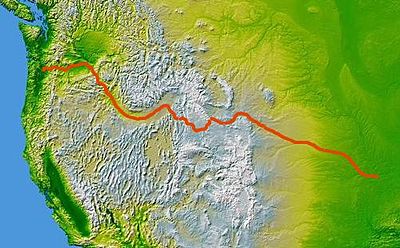
400,000 men, women and children walked 2,000 miles
in six months in wagon trains on the Oregon Trail |
trail from the Missouri river to the Willamette Valley: about
2,000 miles. Some people went eastward on the Oregon Trail. Some did so
because they were discouraged and defeated. Some returned with bags of
gold and silver. Most were returning to pick up their families and move
them all back west. These "gobacks" were a major source of information
and excitement about the wonders and promises—and dangers and disappointments—of
the far west.
Mormons and Utah
Brigham Young, seeking to leave American jurisdiction
to escape religious persecution in Illinois and Missouri, led the Mormons
to the valley of the Great Salt Lake, owned at the time by Mexico but not
controlled by them. A hundred rural Mormon settlements sprang up in what
Young called "Deseret", which he ruled as a theocracy. It later became
Utah Territory. Young's Salt Lake City settlement served as the hub of
their network, which reached into neighboring territories as well. The
communalism and advanced farming practices of the Mormons enabled them
to succeed. They sold goods to wagon trains passing through and came to
terms with local Indian tribes because Young decided it was cheaper to
feed the Indians than fight them. Education became a high priority to protect
the beleaguered group, reduce heresy and maintain group solidarity.
The great threat to the Mormon kingdom in Utah was the
U.S. government, which took ownership of Utah in 1848 and, pushed by the
Protestant churches, rejected theocracy and polygamy. Confrontations verged
on open warfare in the late 1850s as President Buchanan sent in troops.
There were no battles, and negotiations led to a stand down. The Republican
Party swore to destroy polygamy, which it saw as an affront to religious,
cultural and moral values of a modern civilization. After the Civil War
the federal government systematically took control of Utah away from the
Mormons, and drove the church's leadership underground. Meanwhile, aggressive
missionary work in the U.S. and Europe brought a flood of Mormon converts
to Utah. Finally in 1890 the Church leadership announced polygamy was no
longer a central tenet, and a compromise was reached, with Utah becoming
a state and the Mormons dividing into Republicans and Democrats.
The Pony Express and the telegraph
| The federal government provided subsidies for the development
of mail and freight delivery, and by 1856, Congress authorized road improvements
and an overland mail service to California. The new commercial wagon trains
service primarily hauled freight. In 1858 John Butterfield (1801–69) established
a stage service that went from Saint Louis to San Francisco in 24 days
along a southern route. This route was abandoned in 1861 after Texas joined
the Confederacy, in favor of stagecoach services established via Fort Laramie
and Salt Lake City, a 24 day journey, with Wells Fargo & Co. as the
foremost provider (initially it used the old "Butterfield" name).
William Russell, hoping to get a government contract for
more rapid mail delivery service, started the Pony Express in 1860, cutting
delivery time to ten days. He set up over 150 stations about 15 miles (24
km) apart.
In 1861 Congress passed the Land-Grant Telegraph Act which
financed the construction of Western Union's transcontinental |
.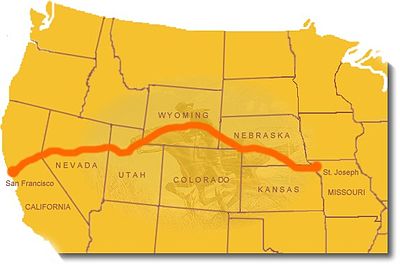
Map of Pony Express route |
telegraph lines. Hiram Sibley, Western Union's head, negotiated
exclusive agreements with railroads to run telegraph lines along their
right-of-way. Eight years before the transcontinental railroad opened,
the First Transcontinental Telegraph linked Omaha, Nebraska and San Francisco
(and points in-between) on October 24, 1861. The Pony Express ended in
just 18 months because it could not compete with the telegraph.
Bleeding Kansas
| Constitutionally, Congress could not deal with slavery
in the states but it did have jurisdiction in the western territories.
California unanimously rejected slavery in 1850 and became a free state.
New Mexico allowed slavery, but it was rarely seen there. Kansas was off
limits to slavery by the Compromise of 1820. Free Soil elements feared
that if slavery were allowed rich planters would buy up the best lands
and work them with gangs of slaves, leaving little opportunity for free
white men to own farms. Few Southern planters were actually interested
in Kansas, but the idea that slavery was illegal there implied they had
a second-class status that was intolerable to their sense of honor, and |
.
The massacre of anti-slavery
Kansans. May 19, 1858. |
seemed to violate the principle of state's rights. With the
passage of the extremely controversial Kansas-Nebraska Act in 1854, Congress
left the decision up to the voters on the ground in Kansas. Across the
North a new major party was formed to fight slavery: the Republican Party,
with numerous westerners in leadership positions, most notably Abraham
Lincoln of Illinois. To influence the territorial decision, anti-slavery
elements (also called "Jayhawkers" or "Free-soilers") financed the migration
of politically determined settlers. But pro slavery advocates fought back
with pro slavery settlers from Missouri. Violence on both sides was the
result; in all 56 men were killed by the time the violence abated in 1859.
By 1860 the pro slavery forces were in control—but Kansas had only two
slaves. The antislavery forces took over by 1861, as Kansas became a free
state. The episode demonstrated that a democratic compromise between North
and South over slavery was impossible and served to hasten the Civil War.
Civil War in the West
| The Trans-Mississippi theater
The Confederacy engaged in several important campaigns
in the West. However, Kansas, a major area of conflict building up to the
war, was the scene of only one battle, at Mine Creek. But its proximity
to Confederate lines enabled pro Confederate guerrillas, such as Quantrill's
Raiders, to attack Union strongholds and massacre the residents.
In Texas, citizens voted to join the Confederacy; anti-war
Germans were hanged. Local troops took over the federal arsenal in San
Antonio, with plans to grab the territories of northern New Mexico, Utah,
and Colorado, and possibly California. Confederate Arizona was created
by Arizona citizens who wanted protection against Apache raids after the
United States Army units were moved out. At the Battle of Glorieta Pass,
the Union ended the Confederate campaign and the area west of Texas remained
in Union hands.
Missouri, a Union state where slavery was legal, became
a battleground when the pro-secession |
.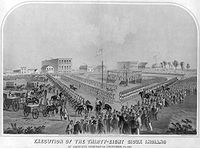
Mass hanging of Sioux warriors
convicted of murder and rape in
Mankato, Minnesota, 1862 |
governor, against the vote of the legislature, led
troops to the federal arsenal at St. Louis; he was aided by Confederate
forces from Arkansas and Louisiana. However Union General Samuel Curtis
regained St. Louis and all of Missouri for the Union. The state was the
scene of numerous raids and guerrilla warfare in the west.
Wartime Indian fighting
The most dramatic development was the Sioux war in Minnesota
in 1862, when Dakota tribes systematically attacked German farms in an
effort to drive out the settlers. Over a period of several days, Dakota
attacks at the Lower Sioux Agency, New Ulm and Hutchinson, slaughtered
300 to 400 white settlers. The state militia fought back and Lincoln sent
in federal troops. The ensuing battles at Fort Ridgely, Birch Coulee, Fort
Abercrombie, and Wood Lake punctuated a six week war, which ended in American
victory. The federal government tried 425 Indians for murder; 303 were
convicted and sentenced to death. Lincoln pardoned the majority; 38 leaders
were hanged .
The decreased presence of Union troops in the West left
behind untrained militias; hostile tribes used the opportunity to attack
settlers. The militia struck back hard, most notably by attacking the winter
quarters of the Cheyenne and Arapaho Indians, filled with women and children,
at the Sand Creek massacre in eastern Colorado in late 1864.
Kit Carson and the U.S. Army in 1864 trapped the entire
Navajo tribe in New Mexico, where they had been raiding settlers, and put
them on a reservation.] Within the Indian Territory, now Oklahoma, conflicts
arose among the Five Civilized Tribes, most of which sided with the South
being slave holders themselves.
In 1862, Congress enacted two major laws to facilitate
settlement of the West: the Homestead Act and the Pacific Railroad Act.
The result by 1890 was millions of new farms in the Plains states, many
operated by new immigrants from Germany and Scandinavia.
The Postbellum West
| Territorial governance after the Civil War
With the war over and slavery abolished, the federal government
focused on improving the governance of the territories. It subdivided several
territories, preparing them for statehood, following the precedents set
by the Northwest Ordinance of 1787. It standardized procedures and the
supervision of territorial governments, taking away some local powers,
and imposing much "red tape", growing the federal bureaucracy significantly.
Federal involvement in the territories was considerable.
In addition to direct subsidies, the federal |
.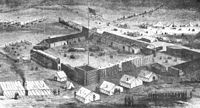
Camp Supply Stockade, February 1869 |
government maintained military posts, provided safety from
Indian attacks, bankrolled treaty obligations, conducted surveys and land
sales, built roads, staffed land offices, made harbour improvements, and
subsidized overland mail delivery. Territorial citizens came to both decry
federal power and local corruption, and at the same time, lament that more
federal dollars were not sent their way.
Territorial governors were political appointees and beholden
to Washington so they usually governed with a light hand, allowing the
legislatures to deal with the local issues. In addition to his role as
civil governor, a territorial governor was also a militia commander, a
local superintendent of Indian affairs, and the state liaison with federal
agencies. The legislatures, on the other hand, spoke for the local citizens
and they were given considerable leeway by the federal government to make
local law.
These improvements to governance still left plenty of
room for profiteering. As Mark Twain wrote while working for his brother,
the secretary of Nevada, "The government of my country snubs honest simplicity,
but fondles artistic villainy, and I think I might have developed into
a very capable pickpocket if I had remained in the public service a year
or two." "Territorial rings", corrupt associations of local politicians
and business owners buttressed with federal patronage, embezzled from Indian
tribes and local citizens, especially in the Dakota and New Mexico territories.
| Federal land system
In acquiring, preparing, and distributing public land
to private ownership, the federal government generally followed the system
set forth by the Land Ordinance of 1785. Federal exploration and scientific
teams would undertake reconnaissance of the land and determine Native American
habitation. Through treaty, land title would be ceded by the resident tribes.
Then surveyors would create detailed maps marking the land into squares
of six miles (10 km) on each side, subdivided first into one square mile
blocks, then into 160 acre (0.65 km2) lots. Townships would be formed from
the lots and sold at public auction. Unsold land could be purchased from
the land office at a minimum price of $1.25 per acre.
As part of public policy, the government would award public
land to certain groups such as veterans, |
.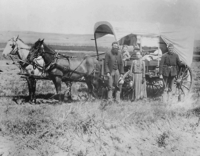
Homesteaders |
through the use of "land script". The script traded
in a financial market, often at below the $1.25 per acre minimum price
set by law, which gave speculators, investors, and developers another way
to acquired large tracts of land cheaply. Land policy became politicized
by competing factions and interests, and the question of slavery on new
lands was contentious. As a counter to land speculators, farmers formed
"claims clubs" to enable them to buy larger tracts than the 160 acre (0.65
km2) allotments by trading among themselves at controlled prices.
In 1862, Congress passed three important bills that impacted
the land system. The Homestead Act granted 160 acres (0.65 km2) to each
settler who improved the land for five years, to citizens and non citizens
including squatters and women, for no more than modest filing fees. The
law was especially important in the settling of the Plains states, although
many farmers purchased their land from railroads at low rates.
The Pacific Railway Acts of 1862 provided for the land
needed to build the transcontinental railroad. The land given the railroads
alternated with government owned tracts saved for distribution to homesteaders.
In an effort to be equitable, the federal government reduced each tract
to 80 acres (320,000 m2) because of its perceived higher value given its
proximity to the rail line. Railroads had up to five years to sell or mortgage
their land, after tracks were laid, after which unsold land could be purchased
by anyone. Often railroads sold some of their government acquired land
to homesteaders immediately to encourage settlement and the growth of markets
the railroads would then be able to serve. Nebraska railroads in the 1870s
were strong boosters of lands along their routes. They sent agents to Germany
and Scandinavia with package deals that included cheap transportation for
the family as well as its furniture and farm tools, and they offered long-term
credit at low rates. Boosterism succeeded in attracting adventurous American
and European families to Nebraska, helping them purchase land grant parcels
on good terms. The selling price depended on such factors as soil quality,
water, and distance from the railroad.
The Morrill Act of 1862 provided land grants to states
to begin colleges of agriculture and mechanical arts (engineering). The
goal was to open new universities and make farming more scientific and
profitable.
Transcontinental railroads
| In the 1850s government sponsored surveys to chart the
remaining unexplored regions of the West, and to plan possible routes for
a transcontinental railroad. Much of this work was undertaking by the U.S.
Army's Corps of Engineers, Corps of Topographical Engineers, and Bureau
of Explorations and Surveys, and became known as "The Great Reconnaissance."
Regionalism animated debates in Congress regarding the choice of a northern,
central or southern route. Engineering requirements for the rail route
were an adequate supply of water and wood, and as nearly level route as
possible, given the weak locomotives of the era. By 1855, a twelve volume
report was issued but without any recommendation for a preferred route,
but providing numerous options as well as providing a wealth of scientific
knowledge.
In the 1850s proposals to build a transcontinental failed
because of the disputes over slavery in Washington; with the secession
of the Confederate states in 1861, the modernizers in the |
.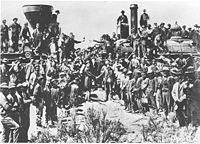
The meeting of the lines on
May 10, 1869 |
Republican party took over Congress and wanted a line to
link to California. With a war underway it was impossible for the federal
government to build the line; funding had to come from Europe, with the
construction done by American firms using unskilled laborers who would
live in temporary camps along the way. Men from China and Ireland would
do most of the construction work. Theodore Judah, the chief engineer of
the Central Pacific surveyed the route from San Francisco east. Judah's
tireless lobbying efforts in Washington were largely responsible for the
passage of the 1862 Pacific Railroad Act, which authorized construction
of both the Central Pacific and the Union Pacific (which built west from
Omaha). In 1862 four rich San Francisco merchants (Leland Stanford, Collis
Huntington, Charles Crocker, and Mark Hopkins) took charge, with Crocker
in charge of construction. Construction was completed in 1869, when the
golden spike was hammered on May 10, 1869, touching off a national celebration.
Coast to coast passenger travel in 8 days now replaced wagon trains or
sea voyages that took 6 to 10 months and cost much more.
The road was built with mortgages from New York, Boston
and London, backed by land grants. There were no federal cash subsidies;
instead the federal government offered land grants in a checkerboard pattern.
The railroad sold every other square, with the government opening its half
to homesteaders. The government also loaned money—later repaid—at $16,000
per mile on level stretches, and $32,000 to $48,000 in mountainous terrain.
Local and state governments also aided the financing.
Fleisig questions whether promoters of the Central Pacific
Railroad were oversubsidized. He finds that subsidies were not an economic
necessity because they "influenced neither the decision to invest in the
railroad nor the speed of its construction." He estimates the rate of return
for the railroad developers using government funds range from 71% to 200%,
while estimates of private rates of return range from 15% to 25%. Mercer
analyzes the impact of land grants, during 1864-90, on rates of return
for the Central Pacific. He finds that even without land grants, the rates
of return were high and that the land grants did not pay for the construction
of the railroad. However they did produce large social returns in western
states by accelerating construction of the system. Tutorow argues that
the Big Four paid lip service to the idea of free competition but in practice
sought to destroy or weaken competing railroad and shipping lines. They
repeatedly entered into pooling arrangements to prevent competition, bought
out competitors, or forced rivals to agree not to compete with them. He
concludes that Stanford and his partners viewed laissez-faire as applicable
only to government controls and not to destruction of unwanted competition.
Most of the manual laborers on the Central Pacific were
new arrivals from China. Kraus shows how these men lived and worked, and
how they managed their money. He concludes that senior officials quickly
realized the high degree of cleanliness and reliability of the Chinese.
The Central Pacific employed over 12,000 Chinese workers, 90% of its manual
work force. Ong explores whether or not the Chinese workers were exploited
by the railroad. He finds the railroad set different wage rates for whites
and Chinese and used the latter in the more menial and dangerous jobs,
with whites in the better positions. However the railroad also provided
camps and food the Chinese wanted and protected the Chinese workers from
threats from whites.
Building the railroad required six main activities: surveying
the route, blasting a right of way, building tunnels and bridges, clearing
and laying the roadbed, laying the ties and rails, and maintaining and
supplying the crews with food and tools. The work was highly physical,
using horse drawn plows and scrapers, and manual picks, axes, sledgehammers,
and handcarts. A few steam driven machines, such as shovels, were used.
The rails were iron (steel came a few years later) and weighed 700 lb (320
kg). and required five men to lift. For blasting, they used black powder.
The Union Pacific construction crews, mostly Irish Americans, averaged
about two miles (3 km) of new track per day.
Six transcontinental railroads were built in the Gilded
Age (plus two in Canada); they opened up the West to farmers and ranchers.
From north to south they were the Northern Pacific, Milwaukee Road, and
Great Northern along the Canadian border; the Union Pacific/Central Pacific
in the middle, and to the south the Santa Fe, and the Southern Pacific.
All but the Great Northern of James J. Hill relied on land grants. The
financial stories were often complex. For example, the Northern Pacific
received its major land grant in 1864. Financier Jay Cooke (1821–1905)
was in charge until 1873, when he went bankrupt. Federal courts, however,
kept bankrupt railroads in operation. In 1881 Henry Villard (1835–1900)
took over and finally completed the line to Seattle. But the line went
bankrupt in the Panic of 1893 and Hill took it over. He then merged several
lines with financing from J.P. Morgan, but President Theodore Roosevelt
broke them up in 1904.
In the first year of operation, 1869–70, 150,000 passengers
made the long trip. Settlers were encouraged with promotions to come West
on free scouting trips to buy railroad land on easy terms spread over several
years. The railroads had "Immigration Bureaus" which advertised package
low-cost deals including passage and land on easy terms for farmers in
Germany and Scandinavia. The prairies, they were promised, did not mean
backbreaking toil because "settling on the prairie which is ready for the
plow is different from plunging into a region covered with timber." The
settlers were customers of the railroads, shipping their crops and cattle
out, and bringing in manufactured products. All manufacturers benefited
from the lower costs of transportation and the much larger radius of business.
White concludes with a mixed verdict. The transcontinentals
did open up the West to settlement, brought in many thousands of high-tech,
highly paid workers and managers, created thousands of towns and cities,
oriented the nation onto an east west axis, and proved highly valuable
for the nation as a whole. On the other hand too many were built, and they
were built too far ahead of actual demand. The result was a bubble that
left heavy losses to investors, and led to poor management practices. By
contrast, as White notes, the lines in the Midwest and East supported by
a very large population base, fostered farming, industry and mining while
generating steady profits and receiving few government benefits.
Migration after the Civil War
After the Civil War, many from the East Coast and Europe
were lured west by reports from relatives and by extensive advertising
campaigns promising "the Best Prairie Lands", "Low Prices", "Large Discounts
For Cash", and "Better Terms Than Ever!". The new railroads provided the
opportunity for migrants to go out and take a look, with special family
tickets, the cost of which could be applied to land purchases offered by
the railroads. Farming the plains was indeed more difficult than back east.
Water management was more critical, lightning fires were more prevalent,
the weather was more extreme, rainfall was less predictable.
The fearful stayed home. The actual migrants looked beyond
fears of the unknown. Their chief motivation to move west was to find a
better economic life than the one they had. Farmers sought larger, cheaper
and more fertile land; merchants and tradesman sought new customers and
new leadership opportunities. Laborers wanted higher paying work and better
conditions.
Oklahoma Land Rush
In 1889, President Benjamin Harrison authorized the opening
of 2,000,000 acres (8,100 km2) of unoccupied lands in the Oklahoma territory
acquired from the native tribes. On April 22, over 100,000 settlers and
cattlemen (known as "boomers") lined up at the border, and with the army's
guns and bugles giving the signal, began a mad dash into the newly opened
land to stake their claims (Land Run of 1889). A witness wrote, "The horsemen
had the best of it from the start. It was a fine race for a few minutes,
but soon the riders began to spread out like a fan, and by the time they
reached the horizon they were scattered about as far as the eye could see".
In one day, the towns of Oklahoma City, Norman, and Guthrie came into existence.
In the same manner, millions of acres of additional land was opened up
and settled in the following four years.
Economic development
One major part of the story of the Old West was the numerous
and diverse forms of business and economic development which drew new migrants
and entrepreneurs there. Some are noted above, such as the Gold Rush and
the cattle boom. It also included some major ventures in mining and other
resources. Another example is the Texas oil boom in the early 20th century.
| American Indian Wars
Indian wars have occurred throughout the United States
though the conflicts are generally separated into two categories; the Indian
wars east of the Mississippi River and the Indian wars west of the Mississippi.
According to the U.S. Bureau of the Census (1894), provided an estimate
of deaths:
"The Indian wars under the government
of the United States have been more than 40 in number. They have cost the
lives of about 19,000 white men, women and children, including those killed
in individual combats, and the lives of about 30,000 Indians."
Indian wars east of the Mississippi
The Trail of Tears
The expansion of migration into the Southeastern United
States in the 1820s to the 1830s forced the federal government to deal
with the "Indian question." The Indians were under federal control but
were independent of state governments. State legislatures and state judges
had no authority on their lands, and the states demanded control. Politically
the new Democratic Party of President Andrew Jackson demanded removal of
the Indians out of the southeastern states to new lands in the west, while
the Whig Party and the Protestant churches were opposed to removal. The
Jacksonian Democracy proved irresistible, as it won the presidential elections
of 1828, 1832 and 1836. By 1837 the "Indian Removal policy" began, to implement
the act of Congress signed by Andrew Jackson in 1830. Many historians have
sharply attacked Jackson. The 1830 law theoretically provided for voluntary
removal and had safeguards for the rights of Indians, but in reality the
removal was involuntary and brutal and ignored safeguards. Jackson justified
his actions by stating that Indians had "neither the intelligence, the
industry, the moral habits, nor the desire of improvements." |
.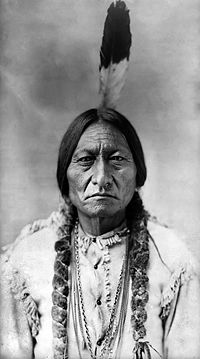
Chief Sitting Bull |
The forced march of about twenty tribes included the "Five
Civilized Tribes" (Creek, Choctaw, Cherokee, Chickasaw, and Seminole).
To motivate natives reluctant to move, the federal government also promised
rifles, blankets, tobacco, and cash. By 1835 the Cherokee, the last Indian
nation in the South, had signed the removal treaty and relocated to Oklahoma.
All the tribes were given new land in the "Indian Territory" (which later
became Oklahoma). Of the approximate 70,000 Indians removed, about 20%
died from disease, starvation, and exposure on the route. This exodus has
become known as The Trail of Tears (in Cherokee "Nunna dual Tsuny," "The
Trail Where they Cried"). The impact of the removals was severe. The transplanted
tribes had considerable difficulty adapting to their new surroundings and
sometimes clashed with the tribes native to the area.
The only way for an Indian to remain and avoid removal
was to accept the federal offer of 640 acres (2.6 km2) or more of land
(depending on family size) in exchange for leaving the tribe and becoming
a state citizen subject to state law and federal law. However, many natives
who took the offer were defrauded by "ravenous speculators" who stole their
claims and sold their land to whites. In Mississippi alone, fraudulent
claims reached 3,800,000 acres (15,000 km2). Of the five tribes, the Seminole
offered the most resistance, hiding out in the Florida swamps and waging
a war which cost the U.S. Army 1,500 lives and $20 million.
Indian wars west of the Mississippi
| Indian wars were fought throughout the western United
States, however, according to Gregory Michno, there were more conflicts
in the states bordering Mexico than in the interior states. Arizona ranked
highest, with 310 known battles fought within the state's boundaries between
Americans and the natives. Also, when determining how many deaths resulted
from the wars, in each of the American states, Arizona ranked highest.
At least 4,340 people were killed, including soldiers, civilians and native
Americans, over twice as many as occurred in Texas, the second highest
ranking state. Most of the deaths in Arizona were caused by the Apache.
Michno also says that fifty-one percent of the Indian war battles between
1850 and 1890 took place in Arizona, Texas and New Mexico, as well as thirty-seven
percent of the casualties in the county west of the Mississippi River.
In the Apache Wars, Colonel Christopher "Kit" Carson forced
the Mescalero Apache onto a reservation in 1862. In 1863-1864, Carson used
a scorched earth policy in the Navajo Campaign, burning Navajo fields and
homes, and capturing or killing their livestock. He was aided by other
Indian tribes with long standing enmity toward the Navajos, chiefly the
Utes. |
.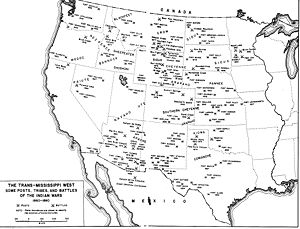
Indian battles in the Trans Mississippi West |
In the Red River War 1874-75 the U.S. army forced the
Comanche to return to their reservation by killing their horses; the last
Comanche war chief, Quanah Parker, surrendered in June 1875.
Red Cloud's War was led by the Lakota chief Red Cloud
against the military who were erecting forts along the Bozeman trail. It
was the most successful campaign against the U.S. during the Indian Wars.
By the Treaty of Fort Laramie (1868), the U.S. granted a large reservation
to the Lakota, without military presence; it included the entire Black
Hills.
| Captain Jack was a chief of the Native American Modoc
tribe of California and Oregon, and was their leader during the Modoc War.
With 53 Modoc warriors, Captain Jack held off 1,000 men of the U.S. Army
for 7 months. Captain Jack killed Edward Canby.
In June 1877, in the Nez Perce War the Nez Perce under
Chief Joseph, unwilling to give up their traditional lands and move to
a reservation, undertook a 1,200 mile fighting retreat from Oregon to near
the Canadian border in Montana. Numbering only 200 warriors, the Nez Perce
"battled some 2,000 American regulars and volunteers of different military
units, together with their Indian auxiliaries of many tribes, in a total
of eighteen engagements, including four major battles and at least four
fiercely contested skirmishes." The Nez Perce were finally surrounded at
the Battle of Bear Paw and surrendered. |
.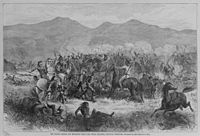
The battle near Fort Phil Kearny,
Dakota Territory, December 21, 1866 |
The Great Sioux War of 1876-77 was conducted by the Lakota
under Sitting Bull and Crazy Horse. The conflict began after repeated violations
of the Treaty of Fort Laramie (1868) once gold was discovered in the hills.
One of its famous battles was the Battle of the Little Bighorn, in which
combined Sioux and Cheyenne forces defeated the 7th Cavalry, led by General
George Armstrong Custer.
Many of the Apache had been at war the Spanish and Mexicans
for almost three centuries when the US annexed present day Arizona and
New Mexico in 1848. The U.S. finally induced the last hostile Apache band
under Geronimo to surrender in 1886. (See Apache-Mexico Wars Apache wars)
The end of the Indian wars came at the Wounded Knee Massacre
on December 29, 1890 where the 7th Cavalry attempted to disarm a Sioux
man and precipitated an engagement in which about 150 Sioux men, women,
and children were killed. Only thirteen days before, Sitting Bull had been
killed with his son Crow Foot in a gun battle with a group of Indian police
that had been sent by the American government to arrest him.
According to the U.S. Bureau of the Census (1894), "The
Indian wars under the government of the United States have been more than
40 in number. They have cost the lives of about 19,000 white men, women
and children, including those killed in individual combats, and the lives
of about 30,000 Indians."
Forts and outposts
As the frontier moved westward, the establishment of U.S.
military forts moved with it, representing and maintaining federal sovereignty
over new territories. The military garrisons usually lacked defensible
walls but were seldom attacked. They served as bases for troops at or near
strategic areas, particularly for counteracting the Indian presence. For
example, Fort Bowie protected Apache Pass in southern Arizona along the
mail route between Tucson and El Paso and was used to launch attacks against
Cochise and Geronimo. Fort Laramie and Fort Kearny helped protect immigrants
crossing the Great Plains and a series of posts in California protected
miners. Forts were constructed to launch attacks against the Sioux. As
Indian reservations sprang up, the military set up forts to protect them.
Forts also guarded the Union Pacific and other rail lines. Other important
forts were Fort Sill, Oklahoma, Fort Smith, Arkansas, Fort Snelling, Minnesota,
Fort Union, New Mexico, Fort Worth, Texas, and Fort Walla Walla in Washington.
Fort Omaha, Nebraska was home to the Department of the Platte, and was
responsible for outfitting most Western posts for more than 20 years after
its founding in the late 1870s. Fort Huachuca in Arizona was also originally
a frontier post and is still in use by the United States Army.
| Indian reservations
Settlers on their way overland to Oregon and California
became targets of Indian threats. Robert L. Munkres read 66 diaries of
parties traveling the Oregon Trail between 1834 and 1860 to estimate the
actual dangers they faced from Indian attacks in Nebraska and Wyoming.
The vast majority of diarists reported no armed attacks at all. However
many did report harassment by Indians who begged or demanded tolls, and
stole horses and cattle. Madsen reports that the Shoshoni and Bannock tribes
north and west of Utah were more aggressive toward wagon trains. The federal
government attempted to reduce tensions and create new tribal boundaries
in the Great Plains with two new treaties in the early 1850, The Treaty
of Fort Laramie established tribal zones for the Sioux, Cheyennes, Arapahos,
Crows, and others, and allowed for the building of roads and posts across
the tribal lands. A second treaty secured safe passage along the Santa
Fe Trail for wagon trains. In return, the tribes would receive, for ten
years, annual compensation for damages caused by migrants. |
.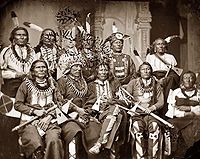
Native American chiefs, 1865 |
The Kansas and Nebraska territories also became contentious
areas as the federal government sought those lands for the future transcontinental
railroad. In the Far West settlers began to occupy land in Oregon and California
before the federal government secured title from the native tribes, causing
considerable friction. In Utah, the Mormons also moved in before federal
ownership was obtained.
A new policy of establishing reservations came gradually
into shape after the boundaries of the "Indian Territory" began to be ignored.
In providing for Indian reservations, Congress and the Office of Indian
Affairs hoped to de-tribalize Native Americans and prepare them for integration
with the rest of American society, the "ultimate incorporation into the
great body of our citizen population." This allowed for the development
of dozens of river front towns along the Missouri River in the new Nebraska
Territory, which was carved from the remainder of the Louisiana Purchase
after the Kansas-Nebraska Act. Influential pioneer towns included Omaha,
Nebraska City and St. Joseph.
American attitudes towards Indians during this period
ranged from malevolence ("the only good Indian is a dead Indian") to misdirected
humanitarianism (Indians live in "inferior" societies and by assimilation
into white society they can be redeemed) to somewhat realistic (Native
Americans and settlers could co-exist in separate but equal societies,
dividing up the remaining western land). Dealing with nomadic tribes complicated
the reservation strategy and decentralized tribal power made treaty making
difficult among the Plains Indians. Conflicts erupted in the 1850s, resulting
in various Indian wars.
| Social history
Scholars have examined the social history of the west
in search of the American character. The history of Kansas, argued historian
Carl L. Becker a century ago, reflects American ideals. He wrote: "The
Kansas spirit is the American spirit double distilled. It is a new grafted
product of American individualism, American idealism, American intolerance.
Kansas is America in microcosm."
Race and ethnicity
European-Americans
European immigrants often built communities of similar
religious and ethnic backgrounds. For example, many Finns went to Minnesota
and Michigan, Swedes to South Dakota, Norwegians to North Dakota, Irish
to Montana, Chinese to San Francisco, German Mennonites in Kansas, and
German Jews to Portland, Oregon. |
.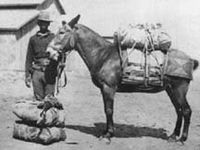
A Buffalo Soldier. The nickname was
given to the "Black Cavalry" by
the Native American tribes
they fought. |
African-Americans
Blacks served in expeditions that mapped the West and
as fur traders, miners, cowboys, Indian fighters, scouts, woodsmen, farm
hands, saloon workers, cooks, and outlaws. The famed Buffalo Soldiers were
soldiers in the all black regiments of the U.S. Army (with white officers).
They served in numerous western forts. About 4000 blacks came to California
in Gold Rush days.
In 1879, after the end of Reconstruction in the South,
thousands of Freedmen moved from Southern states to Kansas. Known as the
Exodusters, they were lured by the prospect of good, cheap land and better
treatment. The all black town of Nicodemus, Kansas, which was founded in
1877, was an organized settlement that predates the Exodusters but is often
associated with them.
Asians and Hispanics
The California Gold Rush set off large migrations of Hispanic
and Asian people which continued after the Civil War. Chinese migrants,
many of whom were impoverished peasants, provided the major part of the
workforce for the building of Central Pacific portion of the transcontinental
railroad. Most of them went home by 1870 when the railroad was finished
but thousands stayed on. They also worked in mining, agriculture, and small
businesses, and many lived in San Francisco. Significant numbers of Japanese
also arrived in Hawaii and California as permanent settlers.
Many Hispanics who had been living in the former territories
of New Spain, lost their land rights to fraud and governmental action when
Texas, New Mexico, and California were formed. In some cases, Hispanics
were simply driven off their land. In Texas, the situation was most acute,
as the "Tejanos", who made up about 75% of the population, ended up as
laborers employed by the large white ranches which took over their land.
In New Mexico, only six percent of all claims by Hispanics were confirmed
by the Claims Court. As a result, many Hispanics became permanently migrating
workers, seeking seasonal employment in farming, mining, ranching, and
on the railroads. Border towns sprang up with barrios of intense poverty.
In response, some Hispanics joined labor unions, and in a few cases, led
revolts. The California "Robin Hood", Joaquin Murieta, led a gang in the
1850s which burned houses, killed miners, and robbed stagecoaches. In Texas,
Juan Cortina led a 20 year campaign against Texas land grabbers and the
Texas Rangers, starting around 1859. Instead of the reality of Hispanic
life, in the United States the public's image became one of quaint peasants
happy with their lot.
| Family life
On the Great Plains very few single men attempted to operate
a farm or ranch; farmers clearly understood the need for a hard-working
wife, and numerous children, to handle the many chores, including child
rearing, feeding and clothing the family, managing the housework, and feeding
the hired hands. During the early years of settlement, farm women played
an integral role in assuring family survival by working outdoors. After
a generation or so, women increasingly left the fields, thus redefining
their roles within the family. New conveniences such as sewing and washing
machines encouraged women to turn to domestic roles. The scientific housekeeping
movement, promoted across the land by the media and government extension
agents, as well as county fairs which featured achievements in home cookery
and canning, advice columns for women in the farm papers, and home economics
courses in the schools all contributed to this trend. |
.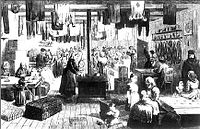
Temporary quarters for
Volga Germans in central Kansas,
1875 |
Although the eastern image of farm life on the prairies
emphasizes the isolation of the lonely farmer and farm life, in reality
rural folk created a rich social life for themselves. They often sponsored
activities that combined work, food, and entertainment such as barn raisings,
corn huskings, quilting bees, Grange meeting, church activities, and school
functions. The womenfolk organized shared meals and potluck events, as
well as extended visits between families.
Childhood
Childhood on the American frontier is contested territory.
One group of scholars, following the lead of novelists Willa Cather and
Laura Ingalls Wilder argue the rural environment was salubrious. Historians
Katherine Harris and Elliott West write that rural upbringing allowed children
to break loose from urban hierarchies of age and gender, promoted family
interdependence, and in the end produced children who were more self-reliant,
mobile, adaptable, responsible, independent and more in touch with nature
than their urban or eastern counterparts. On the other hand historians
Elizabeth Hampsten and Lillian Schlissel offer a grim portrait of loneliness,
privation, abuse, and demanding physical labor from an early age. Riney-Kehrberg
takes a middle position.
Prostitution
Entrepreneurs set up shops and businesses to cater to
the miners. The most famous were the houses of prostitution found in every
mining camp worldwide. Prostitution was a growth industry attracting sex
workers from around the globe, pulled in by the money, despite the harsh
and dangerous working conditions and low prestige. Chinese women were frequently
sold by their families and taken to the camps as prostitutes; they had
to send their earnings back to the family in China. In Virginia City, Nevada,
a prostitute, Julia Bulette, was one of the few who achieved "respectable"
status. She nursed victims of an influenza epidemic; this gave her acceptance
in the community and the support of the sheriff. The townspeople were shocked
when she was murdered in 1867; they gave her a lavish funeral and speedily
tried and hung her assailant. Until the 1890s, madams predominately ran
the businesses, after which male pimps took over, and the treatment of
the women generally declined. The openness of bordellos in western towns
depicted in films was somewhat realistic, allowing for the factor of Hollywood
starlets. Gambling and prostitution were central to life in these western
towns, and only later, as the female population increased, reformers moved
in, and other civilizing influences arrived, did prostitution become less
blatant and less common. After a decade or so the mining towns attracted
respectable women who ran boarding houses, organized church societies,
worked as laundresses and seamstresses, and strove for independent status.
| Law and order
Author Waddy W. Moore uses court records to show that
on the sparsely settled Arkansas frontier lawlessness was common. He distinguished
two types of crimes: unprofessional (dueling, crimes of drunkenness, selling
whiskey to the Indians, cutting trees on federal land) and professional
(horse stealing, highway robbery, counterfeiting). Criminals found many
opportunities to rob pioneer families of their possessions, while the few
under funded lawmen had great difficulty detecting, arresting, holding,
and convicting wrongdoers. However, once convicted, punishment was severe.
Bandits, typically in groups of two or three, rarely attacked stagecoaches
with a guard carrying a sawed-off, double-barreled shotgun; it proved less
risky to rob teamsters, people on foot or solitary horsemen.
The dime novels and Hollywood films had a murder a minute
in western towns, but in reality, law enforcement was much more stringent
than in rural areas. Criminals avoided the cities, leaving the deputies
the main chore of knocking down drunks and hauling them away before they
got hurt. They also disarmed cowboys who violated gun control edicts, tried
to prevent dueling, and dealt with flagrant breaches of gambling and prostitution
ordinances. |
.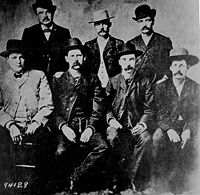
Wyatt Earp, Bat Masterson,
and others on the
Dodge City Peace Commission |
Dykstra argues that the violent image of the cattle towns
in film and fiction is largely myth. The real Dodge City, he says, was
the headquarters for the buffalo hide trade of the Southern Plains and
one of the West's principal cattle towns, a sale and shipping point for
cattle arriving from Texas. He says the second Dodge City belongs to the
popular imagination and thrives as a cultural metaphor for violence, chaos,
and depravity. For the cowboy arriving with money in hand after two months
on the trail, the town was exciting. A contemporary eyewitness of Hays
City, Kansas paints a vivid image of this cattle town:
| "Hays City by lamplight was remarkably lively, but not
very moral. The streets blazed with a reflection from saloons, and a glance
within showed floors crowded with dancers, the gaily dressed women striving
to hide with ribbons and paint the terrible lines which that grim artist,
Dissipation, loves to draw upon such faces... To the music of violins and
the stamping of feet the dance went on, and we saw in the giddy maze old
men who must have been pirouetting on the very edge of their graves." |
Tombstone, Arizona was a notoriously violent mining town
that flourished longer than most, from 1877 to 1929. Silver was discovered
in 1877, and by 1881 the town had a population of over 10,000. Western
story tellers and film makers made as much money in Tombstone as anyone,
thanks to the arrival of Wyatt Earp and his brothers in 1879. They bought
shares in the Vizina mine, water rights, and gambling concessions, but
Virgil, Morgan and Wyatt were soon appointed as federal and local marshals.
They killed three outlaws in the Gunfight at the O.K. Corral, the most
famous gunfight of the Old West. In the aftermath, Virgil Earp was maimed
in an ambush and Morgan Earp was assassinated while playing billiards.
Wyatt and others, including his brother Warren Earp, pursued those they
believed responsible in a vendetta and warrants were issued for their arrest
in the murder of Frank Stilwell. Wyatt later pursued various business interests
in Colorado, Idaho, California, Arizona, and Alaska. Walter Noble Burns's
novel Tombstone (1927) made Earp famous. Hollywood celebrated Earp's Tombstone
days with John Ford's My Darling Clementine (1946), John Sturges's Gunfight
at the O.K. Corral (1957) and Hour of the Gun (1967), Frank Perry's Doc
(1971), George Cosmatos's Tombstone (1993), and Lawrence Kasdan's Wyatt
Earp (1994). They solidified Earp's modern reputation as the Old West's
deadliest gunmen.
| Banditry
Banditry was a major issue in California after 1849, as
thousands of young men detached from family or community moved into a land
with few law enforcement mechanisms. San Francisco solved the problem with
informal citizens' vigilance committees that gave drumhead trials and death
sentences to well known offenders. In rural areas Joaquin Murieta, Jack
Powers, and other bandits terrorized the state. Fatal duels were often
fought to uphold personal honor.
Some of the banditry of the West was carried out by Mexicans
and Indians against white targets of opportunity along the U.S. –Mexico
border, particularly in Texas, Arizona, and California. The second major
type of banditry was conducted by the infamous outlaws of the West, including
Jesse James, Billy the Kid, the Dalton Gang, Black Bart, Butch Cassidy
and the Wild Bunch and hundreds of others who preyed on banks, trains,
and stagecoaches. Some of the outlaws, such as |
.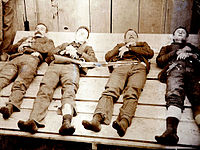
Members of the Dalton Gang
following the
Battle of Coffeyville in 1892. |
Jesse James, were products of the violence of the Civil
War (James had ridden with Quantrill's Raiders) and others became outlaws
during hard times in the cattle industry. Many were misfits and drifters
who roamed the West avoiding the law. When outlaw gangs were near, towns
would raise a posse (like in the movies) to attempt to drive them away
or capture them. Seeing that the need to combat the gunslingers was a growing
business opportunity, Allan Pinkerton ordered his National Detective Agency,
founded in 1850, to open branches out West, and they got into the business
of pursuing and capturing outlaws. There was plenty of business thanks
to the criminal organized and trained by the James Gang, Butch Cassidy,
Sam Bass, and dozens of others. Their names and exploits take a central
role in American folklore, and their guns and costumes become children's
toys.
Range wars
The 1892 Johnson County range war took place in Wyoming's
Powder River country. Daniel Belgrad argues that in the 1880s centralized
range management was the solution to the overgrazing that had depleted
open ranges. Furthermore cattle prices were low. Ranchers were hurt by
mavericking (taking lost, unbranded calves from other ranchers' herds),
and responded by organizing cooperative roundups, blacklisting, and lobbying
for stricter anti-maverick laws. The ranchers formed the Wyoming Stock
Growers' Association, assembled a list of suspected rustlers, and hired
46 gunmen (half from Texas) to hunt down and shoot rustlers. However the
farmers, who occasionally purloined a calf or two, resented the ranchers'
collective political power. The farmers moved toward decentralization and
the use of private winter pastures. The gunmen assembled in April 1892.
The sheriff raised a posse of 200 men and besieged the invading force on
a ranch after they shot two men. The acting governor alerted Washington
which sent the Sixth Cavalry to take custody of the invaders. The courts
freed the Texans. The confrontation represented opposing property rights
systems. The result was the end of the open range system and the ascendancy
of stock ranching and farming. However the popular image depict the episode
an act of vigilantism of aggressive foreign owned firms against small individual
settlers defending their rights.
Buffalo
The rise of the cattle industry and the cowboy is directly
tied to the demise of the huge herds of bison—usually called the "buffalo".
Once numbering over 25 million on the Great Plains, the gradating herds
were a vital resource animal for the Plains Indians, providing food, hides
for clothing and shelter, and bones for implements. Loss of habitat, disease,
and overheating steadily reduced the herds through the 19th century to
the point of near extinction. The last 10-15 million died out in a decade
1872-1883; only 100 survived. The tribes that depended on the buffalo had
little choice but to accept the government offer of reservations, where
the government would feed and supply them on condition they did not go
on the warpath. Conservationists founded the American Bison Society in
1905; it lobbied Congress to establish public bison herds. Several national
parks in the U.S. and Canada were created, in part to provide a sanctuary
for bison and other large wildlife, with no hunting allowed. The bison
population reached 500,000 by 2003.
Cattle
The end of the bison herds opened up millions of acres
for cattle ranching. Spanish cattlemen had introduced cattle ranching and
longhorn cattle to the Southwest in the 17th century, and the men who worked
the ranches, called "vaqueros", were the first "cowboys" in the West. After
the Civil War, Texas ranchers raised large herds of longhorn cattle. The
nearest railheads were 800 or more miles north in Kansas (Abilene, Kansas
City, Dodge City, and Wichita). So once fattened the ranchers and their
cowboys drove the herds north along the Western, Chisholm, and Shawnee
trails. The cattle were shipped to Chicago, St. Louis, and points east
for slaughter and consumption in the fast growing cities. The Chisholm
Trail, laid out by cattleman Joseph McCoy along an old trail marked by
Jesse Chisholm, was the major artery of cattle commerce, carrying over
1.5 million head of cattle between 1867 and 1871 over the 800 miles (1,300
km) from south Texas to Abilene, Kansas. The long drives were treacherous,
especially crossing water such as the Brazos and the Red River and when
they had to fend off Indians and rustlers looking to make off with their
cattle. A typical drive would take three to four months and contained two
miles (3 km) of cattle six abreast. Despite the risks, a successful drive
proved very profitable to everyone involved, as the price of one steer
was $4 in in Texas and $40 back East.
By the 1870s and 1880s, cattle ranches expanded further
north into new grazing grounds and replaced the bison herds in Wyoming,
Montana, Colorado, Nebraska and the Dakota territory, using the rails to
ship to both coasts. Many of the largest ranches were owned by Scottish
and English financiers. The single largest cattle ranch in the entire West
was owned by American John W. Iliff, "cattle king of the Plains", operating
in Colorado and Wyoming. Gradually, longhorns were replaced by the American
breeds of Hereford and Angus, introduced by settlers from the Northwest.
Though less hardy and more disease prone, these breeds produced better
tasting beef and matured faster.
The funding for the cattle industry came largely from
British sources, as the European investors engaged in a speculative extravaganza—a
"bubble". Graham concludes the mania was founded on genuine opportunity,
as well as "exaggeration, gullibility, inadequate communications, dishonesty,
and incompetence." A severe winter engulfed the plains toward the end of
1886 and well into 1887, locking the prairie grass under ice and crusted
snow which starving herds could not penetrate. The British lost most of
their money—as did eastern investors like Theodore Roosevelt, but their
investments did create a large industry that continues to cycle through
boom and bust periods.
On a much smaller scale sheep grazing was locally popular;
sheep were easier to feed and needed less water. However, Americans did
not buy mutton. As farmers moved in open range cattle ranching came to
an end and was replaced by barbed wire spreads where water, breeding, feeding,
and grazing could be controlled. This led to "fence wars" which erupted
over disputes about water rights.
Cowboys
Central to the myth and the reality of the West is the
American cowboy. His real life was a hard one and revolved around two annual
roundups, spring and fall, the subsequent drives to market, and the time
off in the cattle towns spending his hard earned money on food, clothing,
gambling, and prostitution. During winter, many cowboys hired themselves
out to ranches near the cattle towns, where they repaired and maintained
equipment and buildings. On a long drive, there was usually one cowboy
for each 250 head of cattle. Alcohol was everywhere in the West (outside
Mormondom), but on the trail the cowboys were forbidden to drink it.
Before a drive, a cowboy's duties included riding out
on the range and bringing together the scattered cattle. The best cattle
would be selected, roped, and branded, and most male cattle were castrated.
The cattle also needed to be dehorned and examined and treated for infections.
On the long drives, the cowboys had to keep the cattle moving and in line.
The cattle had to be watched day and night as they were prone to stampedes
and straying. The work days often lasted fourteen hours, with just six
hours of sleep. It was grueling, dusty work, with just a few minutes of
relaxation before and at the end of a long day. On the trail, drinking,
gambling, and brawling were often prohibited and fined, and sometimes cursing
as well. It was monotonous and boring work, with food to match: bacon,
beans, bread, coffee, dried fruit, and potatoes. On average, cowboys earned
$30 to $40 per month, because of the heavy physical and emotional toll,
it was unusual for a cowboy to spend more than seven years on the range.
As open range ranching and the long drives gave way to fenced in ranches
in the 1880s, by the 1890s the glory days of the cowboy came to an end,
and the myths about the "free living" cowboy began to emerge.
Many of the cowboys were veterans of the Civil War, particularly
coming from both the Confederacy, and the Union, who returned to their
home towns and found no future, so they went west looking for new opportunities.
Some were Blacks, Hispanics, Native Americans, and even Britons] Nearly
all were in their twenties or teens. The earliest cowboys in Texas learned
their trade, adapted their clothing, and took their jargon from the Mexican
vaqueros or "buckaroos", the heirs of Spanish cattlemen from Andalusia
in Spain. Chaps, the heavy protective leather trousers worn by cowboys,
got their name from the Spanish "chaparreras", and the lariat, or rope,
was derived from "la reata". All the distinct clothing of the cowboy—boots,
saddles, hats, pants, chaps, slickers, bandannas, gloves, and collar less
shirts—were practical and adaptable, designed for protection and comfort.
The cowboy hat quickly developed the capability, even in the early years,
to identify its wearer as someone associated with the West. The most enduring
fashion adapted from the cowboy, popular nearly worldwide today, are "blue
jeans", originally made by Levi Strauss for miners in 1850. It was the
cowboy hat, however, that came to symbolize the American West.
Cowtowns
Anchoring the booming cattle industry of the 1860s and
1870s were the cattle towns in Kansas and Missouri. Like the mining towns
in California and Nevada, cattle towns such as Abilene, Dodge City, and
Ellsworth experienced a short period of boom and bust lasting about five
years. The cattle towns would spring up as land speculators would rush
in ahead of a proposed rail line and build a town and the supporting services
attractive to the cattlemen and the cowboys. If the railroads complied,
the new grazing ground and supporting town would secure the cattle trade.
However, unlike the mining towns which in many cases became ghost towns
and ceased to exist after the ore played out, cattle towns often evolved
from cattle to farming and continued on after the grazing lands were exhausted.
| Conservation and environmentalism
Concern with the protection of the environment became
a new issue in the late 19th century, pitting different interests. On the
one side were the lumber and coal companies who called for maximum exploitation
of natural resources to maximize jobs, economic growth, and their own profit.
In the center were the conservationists, led by Theodore
Roosevelt and his coalition of outdoorsmen, sportsmen, bird watchers and
scientists. They wanted to reduce waste; emphasized the value of natural
beauty for tourism and ample wildlife for hunters; and argued that careful
management would not only enhance these goals but also increase the long
term economic benefits to society by planned harvesting and environmental
protections. Roosevelt worked his entire career to put the issue high on
the national agenda. He was deeply committed to conserving natural resources.
He worked closely with Gifford Pinchot and used the Newlands Reclamation
Act of 1902 to promote federal construction of dams to irrigate small farms
and placed 230 million acres (360,000 mi² or 930,000 km²) under
federal protection. Roosevelt set aside more Federal land, national parks,
and nature preserves than all of his predecessors combined.
Roosevelt explained his position in 1910:
"Conservation means development as
much as it does protection. I recognize the right and duty of
this generation to develop and use
the natural resources of our land but I do not recognize the right
to waste them, or to rob, by wasteful
use, the generations that come after us." |
.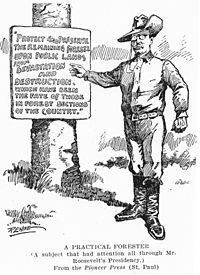
TR's conservation policies |
The third element, smallest at first but growing rapidly
after 1970, were the environmentalists who honored nature for its own sake,
and rejected the goal of maximizing human benefits. Their leader was John
Muir (1838–1914), a widely read author and naturalist and pioneer advocate
of preservation of wilderness for its own sake, and founder of the Sierra
Club. Muir, based in California, in 1889 started organizing support to
preserve the sequoias in the Yosemite Valley; Congress did pass the Yosemite
National Park bill (1890). In 1897 President Grover Cleveland created thirteen
protected forests but lumber interests had Congress cancel the move. Muir,
taking the persona of an Old Testament prophet, crusaded against the lumber
man, portraying it as a contest "between landscape righteousness and the
devil." A master publicist, Muir's magazine articles, in Harper's Weekly
(June 5, 1897) and the Atlantic Monthly turned the tide of public sentiment.
He mobilized public opinion to support Roosevelt's program of setting aside
national monuments, national forest reserves, and national parks. However
Muir broke with Roosevelt and especially President William Howard Taft
on the Hetch Hetchy dam, which was built in the Yosemite National Park
to supply water to San Francisco. Biographer Donald Worster says, "Saving
the American soul from a total surrender to materialism was the cause for
which he fought."
| The American frontier in popular culture
The exploration, settlement, exploitation, and conflicts
of the "American Old West" form a unique tapestry of events, which has
been celebrated by Americans and foreigners alike—in art, music, dance,
novels, magazines, short stories, poetry, theater, video games, movies,
radio, television, song, and oral tradition—which continues in the modern
era. Levy argues that the physical and mythological West inspired composers
Aaron Copland, Roy Harris, Virgil Thomson, Charles Wakefield Cadman, and
Arthur Farwell.
The Frontier Thesis of Wisconsin historian Frederick Jackson
Turner, proclaimed in 1893, established the main lines of historiography
which fashioned scholarship for three or four generations and appeared
in the textbooks used by practically all American students.
|
.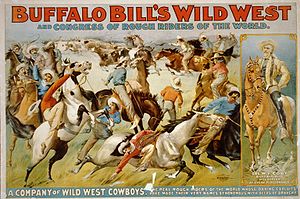
Poster for Buffalo Bill Wild West Show |
Show business
The mythologizing of the West began with minstrel shows
and popular music in the 1840s. During the same period, P. T. Barnum presented
Indian chiefs, dances, and other Wild West exhibits in his museums, However,
large scale awareness really took off when the dime novel appeared in 1859,
the first being Malaeska, the Indian Wife of the White Hunter. By simplifying
reality and grossly exaggerating the truth, the novels captured the public's
attention with sensational tales of violence and heroism, and fixed in
the public's mind stereotypical images of heroes and villains—courageous
cowboys and savage Indians, virtuous lawmen and ruthless outlaws, brave
settlers and predatory cattlemen. Millions of copies and thousands of titles
were sold. The novels relied on a series of predictable literary formulas
appealing to mass tastes and were often written in as little as a few days.
The most successful of all dime novels was Edward S. Ellis' Seth Jones
(1860). Ned Buntline's stories glamorized Buffalo Bill Cody and Edward
L. Wheeler created "Deadwood Dick", "Hurricane Nell", and "Calamity Jane".
Buffalo Bill Cody was the most effective popularizer of
the Old West in the U.S. and Europe. He presented the first "Wild West"
show in 1883, featuring a recreation of famous battles (especially Custer's
Last Stand), expert marksmanship, and dramatic demonstrations of horsemanship
by cowboys and Indians, as well as sure shooting Annie Oakley.
National magazines such as Harper's Weekly featured illustrations
by artists Frederic Remington, Charles M. Russell, and others, and married
them to action filled stories by writers like Owen Wister, together conveying
vivid images of the Old West to the public. By 1901, with an authentic
cowboy and historian of the West in the White House, the publicity was
immense. Remington lamented the passing of an era he helped to chronicle
when he wrote, "I knew the wild riders and the vacant land were about to
vanish forever...I saw the living, breathing end of three American centuries
of smoke and dust and sweat."
Cowboy images
The cowboy has for over a century been the iconic American
image, recognized worldwide and saluted as an authentic hero by Americans.
The best known cowboys are President Theodore Roosevelt (1858–1919) who
made "cowboy" internationally synonymous with the brash aggressive American;
Will Rogers (1879–1935), the leading humorist of the 1920s; Charlie Siringo
(1855–1928); and Andy Adams (1859–1935).
Roosevelt conceptualized the herder (cowboy) as a stage
of civilization distinct from the sedentary farmer—a classic theme well
expressed in the 1944 Hollywood hit Oklahoma! that unveils the conflict
between cowboys and farmers. Roosevelt argued that the manhood typified
by the cowboy—and outdoor activity and sports generally—was essential if
American men were to avoid the softness and rot produced by an easy life
in the city.
Rogers, the son of a Cherokee judge in Oklahoma, started
with rope tricks and fancy riding, but by 1919 discovered his audiences
were even more enchanted with his wit in his representation of the wisdom
of the common man.
Cowboy, Pinkerton detective, and western author, Siringo
was the first authentic cowboy autobiographer. His books helped popularize
the romantic image of the American cowboy.
Adams spent the 1880s and 1890s in the cattle industry
and mining in the Great Plains and Southwest. When an 1898 play's portrayal
of Texans outraged Adams, he started writing plays, short stories, and
novels drawn from his own experiences. His The Log of a Cowboy (1903) became
a classic novel about the cattle business, especially the cattle drive.
It described a fictional drive of the Circle Dot herd from Texas to Montana
in 1882, and became a leading source on cowboy life; historians retraced
his path in the 1960s, confirming his basic accuracy. His writing is acclaimed
and criticized for their fidelity to truth and their lack of literary qualities.
The great cattle drive movie remains Red River (1948)
directed by Howard Hawks, and starring John Wayne and Montgomery Clift.
The unique skills of the cowboys are highlighted in the rodeo. It began
in the 1880s when several Western cities followed up on touring Wild West
shows and organized celebrations that included rodeo activities. The establishment
of major cowboy competitions in the East in the 1920s led to the growth
of rodeo sports. Rodeos combine the traditional skills of the range cowboy
— calf and steer roping, steer wrestling, team roping, bronco riding, and
horsemanship with the showmanship of bull riding, and barrel racing. Historians
Pearson and Haney, have argued that the rodeo cowboys are more than just
athletes; they are cultural icons representing such values as rugged individualism,
patriotism, tradition, masculinity, and courage; they personify the heroic
image of the Old West.
End of the frontier
When the eleventh U.S. Census was taken in 1890, the superintendent
announced that there was no longer a clear line of advancing settlement,
and hence no longer a frontier in the continental United States. Historian
Frederick Jackson Turner used the statistic to announce the end of the
era in which the frontier process shaped the American character.
Fresh farmland was increasingly hard to find after 1890—although
the railroads advertised some in eastern Montana. Bicha shows that nearly
600,000 American farmers sought cheap land by moving to the Prairie frontier
of the Canadian West from 1897 to 1914. However about two thirds of them
grew disillusioned with Canada and returned to the U.S.
Historiography
Scores of Turner students became professors in history
departments in the western states, and taught courses on the frontier.
Scholars have debunked many of the myths of the frontier, but they nevertheless
live on in community traditions, folklore and fiction. In the 1970s a historiographical
range war broke out between the "old" Western histories, which stressed
the influence of the frontier on all of American culture, and the so-called
"new Western history" which looked more narrowly at the trans-Mississippi
West after 1850 and stressed cultural interaction between Americans and
minorities such as Indians and Hispanics. By 2005, Aron argues, the two
sides had "reached an equilibrium in their rhetorical arguments and critiques.".
Meanwhile environmental history has emerged, in large part from the frontier
historiography, hence its emphasis on wilderness.
Since the 1960s an active center is the history department
at the University of New Mexico, along with the University of New Mexico
Press. Leading historians there include Gerald D. Nash, Donald C. Cutter,
Richard N. Ellis, Richard Etulain, Margaret Connell-Szasz, Paul Hutton,
Virginia Scharff, and Samuel Truett. The department has collaborated with
other departments and emphasizes Southwestern regionalism, minorities in
the Southwest, and historiography.
|